how did the election of 1824 change the way presidents were selected?
| | |||||||||||||||||||||||||||||||||||||||||||||||||||||||||||||||||||||||||
| |||||||||||||||||||||||||||||||||||||||||||||||||||||||||||||||||||||||||
| 261 members of the Electoral College 131 electoral votes needed to win | |||||||||||||||||||||||||||||||||||||||||||||||||||||||||||||||||||||||||
|---|---|---|---|---|---|---|---|---|---|---|---|---|---|---|---|---|---|---|---|---|---|---|---|---|---|---|---|---|---|---|---|---|---|---|---|---|---|---|---|---|---|---|---|---|---|---|---|---|---|---|---|---|---|---|---|---|---|---|---|---|---|---|---|---|---|---|---|---|---|---|---|---|---|
| Turnout | 26.9%[i] | ||||||||||||||||||||||||||||||||||||||||||||||||||||||||||||||||||||||||
| |||||||||||||||||||||||||||||||||||||||||||||||||||||||||||||||||||||||||
| Presidential election results map. Blue denotes states won by Jackson, orange denotes those won past Crawford, green denotes those won past Adams, light yellow denotes those won by Clay. Numbers indicate the number of electoral votes allotted to each state. | |||||||||||||||||||||||||||||||||||||||||||||||||||||||||||||||||||||||||
| |||||||||||||||||||||||||||||||||||||||||||||||||||||||||||||||||||||||||
| 1825 contingent U.S. presidential election | |||||||||||||||||||||||||||||||||||||||||||||||||||||||||||||||||||||||||
| |||||||||||||||||||||||||||||||||||||||||||||||||||||||||||||||||||||||||
| 24 state delegations of the Firm of Representatives xiii state votes needed to win | |||||||||||||||||||||||||||||||||||||||||||||||||||||||||||||||||||||||||
| |||||||||||||||||||||||||||||||||||||||||||||||||||||||||||||||||||||||||
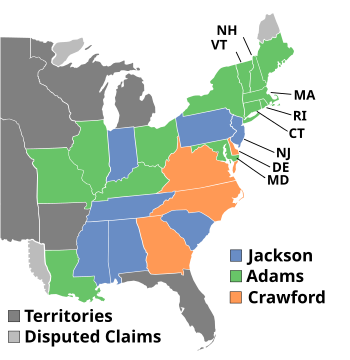 Business firm of Representatives votes by state. States in orange voted for Crawford, states in green for Adams, and states in blue for Jackson. | |||||||||||||||||||||||||||||||||||||||||||||||||||||||||||||||||||||||||
The 1824 United States presidential election was the tenth quadrennial presidential election. It was held from Tuesday, October 26 to Wednesday, December 1, 1824. Andrew Jackson, John Quincy Adams, Henry Clay and William Crawford were the primary contenders for the presidency. The result of the election was inconclusive, as no candidate won a bulk of the electoral vote. In the ballot for vice president, John C. Calhoun was elected with a comfortable majority of the vote. Considering none of the candidates for president garnered an electoral vote majority, the U.S. House of Representatives, under the provisions of the 12th Subpoena, held a contingent election. On February ix, 1825, John Quincy Adams was elected as president without getting the majority of the balloter vote or the popular vote, existence the only president to do so.[2] [three]
The Autonomous-Republican Party had won six sequent presidential elections and by 1824 was the only national political party. However, as the election approached, the presence of multiple viable candidates resulted in in that location being multiple nominations by the contending factions, signaling the splintering of the party and an end to the Era of Good Feelings.
Adams won New England, Jackson and Adams split the mid-Atlantic states, Jackson and Clay split the Western states, and Jackson and Crawford split the Southern states. Jackson finished with a plurality of the balloter and pop vote, while the other iii candidates each finished with a significant share of the votes. Clay, who had finished fourth, was eliminated. Because he shared many of Adams's positions on the major issues, he lent him his support, allowing Adams to win the contingent election on the first ballot.
This is one of two presidential elections (along with the 1800 election) that have been decided in the House. It is also one of v in which the winner did not achieve at least a plurality of the national popular vote, and the only U.S. election in which the candidate who had the plurality of votes in the Electoral College did not win the ballot.
Background [edit]
The Era of Adept Feelings associated with the assistants of President James Monroe was a time of reduced emphasis on political party identity.[iv] With the Federalists discredited, Autonomous-Republicans adopted some key Federalist economic programs and institutions.[v] [vi] The economic nationalism of the Era of Good Feelings that would qualify the Tariff of 1816 and incorporate the Second Banking company of the United states of america portended abandonment of the Jeffersonian political formula for strict construction of the Constitution, express central government, and primacy of Southern slaveholding interests.[7] [8] [9]
An unintended issue of broad unmarried-party identification was reduced party field of study. Rather than political harmony, factions arose within the political party.[x] Monroe attempted to ameliorate discipline by appointing leading statesmen to his Cabinet, including Secretarial assistant of State John Quincy Adams of Massachusetts, Secretary of the Treasury William H. Crawford of Georgia, and Secretary of State of war John C. Calhoun of South Carolina. General Andrew Jackson of Tennessee led high-profile military missions. But Firm Speaker Henry Clay of Kentucky held political power independent of Monroe. He refused to join the cabinet and remained disquisitional of the assistants.
Two central events, the Panic of 1819 and the Missouri crunch of 1820, influenced and reshaped politics.[xi] The economical downturn broadly harmed workers, the sectional disputes over slavery expansion raised tensions, and both events plus other factors collection demand for increased democratic control.[12] Social disaffection would help motivate revival of rivalrous political parties in the near hereafter, though these had non even so formed at the time of the 1824 election.[thirteen]
Nomination procedure [edit]
The previous competition between the Federalist Party and the Democratic-Republican Party collapsed afterward the War of 1812 due to the disintegration of the Federalists' popular appeal. President James Monroe of the Democratic-Republicans was able to run without opposition in the 1820 election. Like previous presidents who had been elected to ii terms, Monroe declined to seek re-nomination for a third term.[14] Vice President Daniel D. Tompkins had long-since been dismissed as a viable successor to Monroe due to a combination of health problems and a financial dispute with the federal government, and he formally ruled himself out of making a presidential run at the offset of 1824.[15] The presidential nomination was thus left wide open within the Democratic-Republican Party, the only major national political entity remaining in the United States.
| Presidential candidate | Ballot | Vice Presidential candidate | Election |
|---|---|---|---|
| William H. Crawford | 64 | Albert Gallatin | 57 |
| Henry Clay | 2 | Erastus Root | 2 |
| John Quincy Adams | 2 | John Quincy Adams | ane |
| Andrew Jackson | 1 | William Eustis | 1 |
| William Rufus King | 1 | ||
| William Lowndes | 1 | ||
| Richard Blitz | ane | ||
| Samuel Smith | i | ||
| John Tod | 1 |
The Congressional conclave nominated Crawford for president and Albert Gallatin for vice president, but information technology was sparsely attended and was widely attacked equally undemocratic. Gallatin had not sought the vice presidential nomination and presently withdrew at Crawford'south asking. Gallatin was also dissatisfied with repeated attacks on his credibility made past the other candidates. He was replaced by North Carolina Senator Nathaniel Macon. State legislatures likewise convened state caucuses to nominate candidates.[16]
Full general election [edit]
Candidates who withdrew before election [edit]
Candidates [edit]
All 4 candidates were nominated by at least i state legislature.[17] Andrew Jackson was recruited to run for the part of the president past the country legislature of Tennessee. Jackson did not seek the task of running for president. Instead, he wished to retire to his estate on the outskirts of Nashville chosen the Hermitage. Notwithstanding, Jackson was not one to refuse such a asking.[18] [ better source needed ]
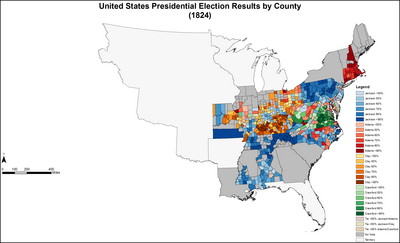
Results by county explicitly indicating the pct of the winning candidate in each canton. Shades of blueish are for Jackson (Democratic-Republican), shades of scarlet are for Adams (Democratic-Republican), shades of yellow are for Clay (Democratic-Republican), and shades of light-green are for Crawford (Democratic-Republican).
Campaign [edit]
Candidates drew voter support past different states and sections. Adams dominated the popular vote in New England and won some support elsewhere, Clay dominated his home state of Kentucky and won pluralities in two neighboring states, and Crawford won the Virginia vote overwhelmingly and polled well in North Carolina. Jackson had geographically the broadest back up, though at that place were heavy vote concentrations in his home state of Tennessee and in Pennsylvania and populous areas where even he ran poorly.
Policy played a reduced office in the election, though positions on tariffs and internal improvements did create significant disagreements. Both Adams and Jackson supporters backed Secretary of War John C. Calhoun of South Carolina for vice president. He easily secured the majority of electoral votes for that function. In reality, Calhoun was vehemently opposed to near all of Adams'southward policies, but he did nix to dissuade Adams supporters from voting for him for vice president.
The campaigning for presidential election of 1824 took many forms. Contrafacta, or well known songs and tunes whose lyrics accept been altered, were used to promote political agendas and presidential candidates. Below can exist found a sound clip featuring "Hunters of Kentucky", a tune written by Samuel Woodsworth in 1815 under the title "The Unfortunate Miss Bailey". Contrafacta such every bit this i, which promoted Andrew Jackson as a national hero, accept been a long-standing tradition in presidential elections. Another form of campaigning during this election was through newsprint. Political cartoons and partisan writings were all-time circulated among the voting public through newspapers. Presidential candidate John C. Calhoun was 1 of the candidates virtually directly involved through his participation in the publishing of the newspaper The Patriot as a fellow member of the editorial staff. This was a sure way to promote his ain political agendas and campaign. In contrast, most candidates involved in early 19th century elections did not run their own political campaigns. Instead it was left to volunteer citizens and partisans to speak on their behalf.[19] [20] [21] [22]
Results [edit]
The 1824 presidential election marked the final collapse of the Republican-Federalist political framework. The electoral map confirmed the candidates' sectional support, with Adams winning in New England, Jackson having wide voter appeal, Clay attracting votes from the Due west, and Crawford attracting votes from the eastern South. Jackson earned only a plurality of electoral votes. Thus, the presidential election was decided by the House of Representatives, which elected John Quincy Adams on the showtime election. John C. Calhoun, supported by Adams and Jackson, easily won the vice presidency, not requiring a contingent election in the Senate.

| Presidential candidate | Party | Home country | Popular vote[a] | Electoral vote | |
|---|---|---|---|---|---|
| Count | Percentage | ||||
| Andrew Jackson[c] | Democratic-Republican | Tennessee | 151,271 | 41.36% | 99 |
| John Quincy Adams[d] | Democratic-Republican | Massachusetts | 113,122 | 30.92% | 84 |
| William Harris Crawford[e] | Autonomous-Republican | Georgia | 40,856 | eleven.21% | 41 |
| Henry Dirt[f] | Democratic-Republican | Kentucky | 47,531 | 12.99% | 37 |
| Unpledged electors | None | Massachusetts | 6,616 | ane.81% | 0 |
| Other | 6,437 | 1.71% | 0 | ||
| Total | 365,833 | 100.0% | 261 | ||
| Needed to win | 131 | ||||
| Vice presidential candidate | Party | Country | Electoral vote[24] |
|---|---|---|---|
| John C. Calhoun | Democratic-Republican | South Carolina | 182 |
| Nathan Sanford | Autonomous-Republican | New York | 30 |
| Nathaniel Macon | Democratic-Republican | Due north Carolina | 24 |
| Andrew Jackson | Democratic-Republican | Tennessee | xiii |
| Martin Van Buren | Autonomous-Republican | New York | 9 |
| Henry Clay | Democratic-Republican | Kentucky | 2 |
| Full | 260 | ||
| Needed to win | 131 | ||
Results by state [edit]

| Andrew Jackson Democratic-Republican | John Quincy Adams Autonomous-Republican | Henry Dirt Autonomous-Republican | William Crawford Autonomous-Republican | State full | ||||||||||||
|---|---|---|---|---|---|---|---|---|---|---|---|---|---|---|---|---|
| State | electoral votes | # | % | balloter votes | # | % | electoral votes | # | % | balloter votes | # | % | balloter votes | # | ||
| Alabama | five | nine,429 | 69.32 | 5 | 2,422 | 17.80 | 0 | 96 | 0.71 | 0 | one,656 | 12.17 | 0 | thirteen,603 | AL | |
| Connecticut | eight | no ballots | 0 | 7,494 | 70.39 | eight | no ballots | 0 | 1,965 | 18.46 | 0 | 10,647 | CT | |||
| Delaware | iii | no popular vote | 0 | no popular vote | 1 | no popular vote | 0 | no popular vote | 2 | – | DE | |||||
| Georgia | 9 | no popular vote | 0 | no popular vote | 0 | no popular vote | 0 | no popular vote | 9 | – | GA | |||||
| Illinois | 3 | 1,272 | 27.23 | ii | 1,516 | 32.46 | 1 | one,036 | 22.xviii | 0 | 847 | 18.xiii | 0 | 4,671 | IL | |
| Indiana | v | 7,343 | 46.61 | five | three,095 | 19.65 | 0 | 5,315 | 33.74 | 0 | no ballots | 0 | xv,753 | IN | ||
| Kentucky | xiv | 6,356 | 27.23 | 0 | no ballots | 0 | 16,982 | 72.77 | 14 | no ballots | 0 | 23,338 | KY | |||
| Louisiana | 5 | no pop vote | three | no popular vote | 2 | no pop vote | 0 | no pop vote | 0 | – | LA | |||||
| Maine | nine | no ballots | 0 | 10,289 | 81.l | 9 | no ballots | 0 | 2,336 | 18.l | 0 | 12,625 | ME | |||
| Maryland | 11 | fourteen,523 | 43.73 | 7 | 14,632 | 44.05 | 3 | 695 | 2.09 | 0 | 3,364 | ten.thirteen | one | 33,214 | Physician | |
| Massachusetts | 15 | no ballots | 0 | xxx,687 | 72.97 | 15 | no ballots | 0 | no ballots | 0 | 42,056 | MA | ||||
| Mississippi | iii | three,121 | 63.77 | 3 | 1,654 | 33.80 | 0 | no ballots | 0 | 119 | 2.43 | 0 | iv,894 | MS | ||
| Missouri | iii | 1,166 | 33.97 | 0 | 159 | 4.63 | 0 | two,042 | 59.50 | 3 | 32 | 0.93 | 0 | 3,273 | MO | |
| New Hampshire | viii | no ballots | 0 | ix,389 | 93.59 | viii | no ballots | 0 | 643 | 6.41 | 0 | 10,032 | NH | |||
| New Jersey | viii | ten,332 | 52.08 | 8 | eight,309 | 41.89 | 0 | no ballots | 0 | 1,196 | 6.03 | 0 | 19,837 | NJ | ||
| New York | 36 | no pop vote | i | no popular vote | 26 | no popular vote | 4 | no popular vote | 5 | – | NY | |||||
| North Carolina | fifteen | 20,231 | 56.03 | fifteen | no ballots | 0 | no ballots | 0 | 15,622 | 43.26 | 0 | 36,109 | NC | |||
| Ohio | 16 | xviii,489 | 36.96 | 0 | 12,280 | 24.55 | 0 | xix,255 | 38.49 | sixteen | no ballots | 0 | l,024 | OH | ||
| Pennsylvania | 28 | 35,929 | 76.04 | 28 | five,436 | 11.l | 0 | 1,705 | 3.61 | 0 | iv,182 | 8.85 | 0 | 47,252 | PA | |
| Rhode Island | 4 | no ballots | 0 | 2,145 | 91.47 | 4 | no ballots | 0 | 200 | 8.53 | 0 | 2,345 | RI | |||
| South Carolina | 11 | no popular vote | xi | no popular vote | 0 | no pop vote | 0 | no popular vote | 0 | – | SC | |||||
| Tennessee | 11 | 20,197 | 97.45 | xi | 216 | 1.04 | 0 | no ballots | 0 | 312 | 1.51 | 0 | 20,725 | TN | ||
| Vermont | 7 | no popular vote | 0 | no popular vote | seven | no popular vote | 0 | no popular vote | 0 | – | VT | |||||
| Virginia | 24 | 2,975 | nineteen.35 | 0 | 3,419 | 22.24 | 0 | 419 | 2.73 | 0 | eight,558 | 55.68 | 24 | fifteen,371 | VA | |
| TOTALS: | 261 | 151,363 | 41.36 | 99 | 113,142 | 30.92 | 84 | 47,545 | 12.99 | 37 | 41,032 | 11.21 | 41 | 365,928 | US | |
| TO WIN: | 131 | |||||||||||||||
Vice presidential electoral vote breakdown by ticket [edit]
| Electoral votes for President | |||||
|---|---|---|---|---|---|
| Total | Andrew Jackson | John Q. Adams | William H. Crawford | Henry Clay | |
| John C. Calhoun | 182 | 99 | 74 | two | 7 |
| Nathan Sanford | xxx | – | – | 2 | 28 |
| Nathaniel Macon | 24 | – | – | 24 | – |
| Andrew Jackson | 13 | – | nine | one | 3 |
| Martin Van Buren | 9 | – | – | 9 | – |
| Henry Dirt | ii | – | – | two | – |
| (No vote for vice president) | one | – | 1 | – | – |
| Total | 261 | 99 | 84 | 40 | 38 |
Close states [edit]
States where the margin of victory was under i%:
- Maryland 0.32% (109 votes)
States where the margin of victory was nether v%:
- Ohio one.53% (766 votes)
States where the margin of victory was under x%:
- Illinois v.23% (244 votes)
1825 contingent election [edit]
As no presidential candidate had won an absolute balloter vote majority, the responsibleness for electing a new president devolved upon the U.S. House of Representatives, which held a contingent election on February 9, 1825. Equally prescribed by the 12th Amendment, the Business firm was limited to choosing from among the three candidates who received the most electoral votes: Andrew Jackson, John Quincy Adams, and William Crawford; Henry Dirt, who had finished quaternary, was eliminated.[25] Each country delegation, voting en bloc, had a single vote. There were 24 states at the time, thus an absolute majority of 13 votes was required for victory.
Clay detested Jackson and had said of him, "I cannot believe that killing 2,500 Englishmen at New Orleans qualifies for the various, difficult, and complicated duties of the Chief Magistracy."[26] Moreover, Clay'southward American Organisation was closer to Adams'due south position on tariffs and internal improvements than Jackson'southward. Even if Clay had wished to marshal with Crawford over Jackson, which was highly unlikely in any upshot since Dirt's policy differences with Crawford were even deeper, specially on matters of the tariff, and the fact Crawford had been in poor wellness, no path to victory was evident.
Ignoring the nonbinding directive of the Kentucky legislature that its Business firm delegation cull Jackson, the delegation voted 8–4 for Adams instead. Clay used his political influence in the Business firm to motivate House delegations in states where he had won at least a voting plurality to vote for Adams.[27] Thus, Adams was elected president on the outset ballot,[28] [29] with 13 states, followed by Jackson with seven, and Crawford with four.
Balloting in the contingent election [edit]

Map of House of Representatives delegation votes
| Feb 9, 1825 | |||||||||||||||||||
|---|---|---|---|---|---|---|---|---|---|---|---|---|---|---|---|---|---|---|---|
| Candidate | Votes | % | |||||||||||||||||
| John Quincy Adams | 13 | 54.17 | |||||||||||||||||
| Andrew Jackson | seven | 29.17 | |||||||||||||||||
| William H. Crawford | four | 16.67 | |||||||||||||||||
| Total votes | 24 | 100 | |||||||||||||||||
| Votes necessary | xiii | 54.17 | |||||||||||||||||
Sources: [30] [31] [32] | |||||||||||||||||||
Aftermath [edit]
Adams' victory shocked Jackson, who, as the winner of a plurality of both the pop and electoral votes, expected the House to choose him. Not long before the contingent Business firm election, an anonymous statement appeared in a Philadelphia newspaper, called the Columbian Observer. The statement, said to be from a fellow member of Congress, essentially defendant Clay of selling Adams his back up for the function of Secretary of Country. No formal investigation was conducted, so the affair was neither confirmed nor denied. When Dirt was indeed offered the position after Adams was victorious, he opted to accept and continue to support the administration he voted for, knowing that declining the position would not have helped to dispel the rumors brought confronting him.[33]
By appointing Dirt his Secretary of State, President Adams essentially alleged him heir to the presidency, as Adams and his three predecessors had all served as Secretary of State. Jackson and his followers defendant Adams and Dirt of striking a "corrupt bargain", and the Jacksonians would campaign on this claim for the next iv years, ultimately helping Jackson defeat Adams in 1828.
Electoral College selection [edit]

Conclave curs in full yell, by James Akin, 1824 (critique of "the press's handling of Andrew Jackson, and on the practice of nominating candidates by caucus")[34]
| Method of choosing electors | State(due south) |
|---|---|
| Each elector chosen by voters statewide |
|
| Each elector appointed past state legislature |
|
| Land divided into electoral districts, with i elector chosen per commune past the voters of that district |
|
| Maine |
See as well [edit]
- The states presidential elections in which the winner lost the popular vote
- 1876 United States presidential election
- 1888 United states of america presidential election
- 2000 United States presidential election
- 2016 United States presidential election
Notes [edit]
- ^ a b c d east The popular vote figures exclude Delaware, Georgia, Louisiana, New York, South Carolina, and Vermont. In all of these states, the Electors were called by the country legislatures rather than by pop vote.[23]
- ^ Albert Gallatin had originally been nominated to serve as Crawford's running mate, however Gallatin withdrew the nomination and Macon was chosen instead.
- ^ Jackson was nominated by the Tennessee state legislature and past the Democratic Party of Pennsylvania.
- ^ Adams was nominated by the Massachusetts state legislature.
- ^ Crawford was nominated past a caucus of 66 congressmen that chosen itself the "Autonomous members of Congress".
- ^ Clay was nominated by the Kentucky state legislature.
References [edit]
Citations [edit]
- ^ "National General Election VEP Turnout Rates, 1789-Present". United States Election Project. CQ Press.
- ^ Robin Kolodny, "The Several Elections of 1824." Congress & the Presidency: A Journal of Capital Studies 23#2 (1996) online.
- ^ George Dangerfield, George. The Awakening of American Nationalism: 1815-1828 (1965) pp 212–230.
- ^ Ammon, 1958, p. 4: "The phrase 'Era of Skilful Feelings", then inextricably associated with the administration of James Monroe ..."
- ^ Ammon, 1958, p. v: "Almost Republicans like old President [James] Madison readily acknowledged the shift that had taken place within the Republican political party towards Federalist principles and viewed the process without qualms." And p. four: "The Republicans had taken over (as they saw it) that which was of permanent value in the Federal programme." And p. 10: "Federalists had vanished" from national politics.
- ^ Dark-brown, 1966, p. 23: "a new theory of party amalgamation preached the doctrine that party division was bad and that a one-party organization best served the national interest" and "After 1815, stirred by the nationalism of the postal service-war era, and with the Federalists in decline, the Republicans took upward the Federalist positions on a number of the slap-up public issues of the day, sweeping all earlier them every bit they did. The Federalists gave up the ghost."
- ^ Brown, 1966, p. 23: The confederate Republicans, "as a political party of the whole nation ... ceased to be responsive to any particular elements in its constituency. Information technology ceased to be responsive to the South." And "The insistence that slavery was uniquely a Southern concern, not to be touched by outsiders, had been from the get-go a sine qua not for Southern participation in national politics. It underlay the Constitution and its cosmos of a government of limited powers ..."
- ^ Brownish, 1966, p. 24: "Not only did the Missouri crisis make these matters clear [the need to revive strict constructionist principles and tranquility anti-slavery agitation], only 'it gave marked impetus to a reaction against nationalism and affiliation of postwar Republicanism'" and the rise of the Sometime Republicans.
- ^ Ammon, 1971 (James Monroe bio) p. 463: "The problems presented by the [consequences of promoting Federalist economic nationalism] gave an opportunity to the older, more bourgeois [Old] Republicans to reassert themselves by attributing the economical dislocation to a deviation from the principles of the Jeffersonian era."
- ^ Parsons, 2009, p. 56: "Animosity betwixt Federalists and Republicans had been replaced past animosity between Republicans themselves, oft over the same issues that had once separated them from the Federalists."
- ^ Wilentz, 2008, p. 251–252: "The panic ... was pivotal ... the hard times of 1819 and early 1820s revive[d] ... cardinal questions about the nationalist economic policies of the new-manner Republicans under Madison and Monroe, and focused inchoate popular resentments on the banks, especially the 2nd Jitney." p. 252: "The Missouri controversy ... proved for more important than the [incidental] outbursts."
- ^ Wilentz, 2008, p. 252: "Both the panic and the Missouri debates underscored in different ways the overriding question of republic as Americans perceived it. In economic matters, the questions arose primarily every bit a matter of privilege. Should unelected private interests, well connected to government, be permitted to control, to their ain benefit, the economic destiny of the entire nation?"
- ^ Hofstadter, 1947, p. 51: The "general mass of the disaffection to the Regime was not sufficiently concentrated to prevent re-ballot, unopposed, of President Monroe in 1820 in the absence of a national opposition party; but it presently transformed politics in many states. Debtors rushed into politics to defend themselves, and secured moratoriums and relief laws from the legislatures of several Western states ... A pop demand arose for laws to prevent imprisonment for debt, for a national bankruptcy law, and for a new tariff and public land policies. For the first time Americans thought of politics as having an intimate relation to their welfare."
- ^ Ratcliffe, Donald (2015). The One-Party Presidential Contest: Adams, Jackson, and 1824's Five-Horse Race. University Press of Kansas. ISBN9780700621309.
- ^ "U.S. Senate: Daniel D. Tompkins, 6th Vice President (1817-1825)". www.senate.gov.
- ^ Patrick, John J.; Pious, Richard M.; Ritchie, Donald A. (2001). The Oxford Guide to the United States Government . Oxford University Press. p. 93. ISBN978-0-19-514273-0.
- ^ Presidential Elections, 1789-2008 County, State, and National Mapping of Election Data; Donald R. Deskins, Jr., Hanes Walton, Jr., and Sherman C. Puckett; University of Michigan Printing, 2022; p. 80
- ^ Bradley, Harold. "Andrew Jackson". Encyclopaedia Britannica. Encyclopaedia Britannica, inc. Retrieved September fifteen, 2022.
- ^ Hansen, Liane (Oct 5, 2008). "Songs Along The Entrada Trail". Election 2008: On The Campaign Trail (Radio series episode). National Public Radio.
- ^ Hay, Thomas R. (Oct 1934). "John C. Calhoun and the Presidential Campaign of 1824, Some Unpublished Calhoun Letters". The American Historical Review. 40 (1): 82–96. doi:10.1086/ahr/forty.1.82. JSTOR 1838676.
- ^ McNamara, R. (September 2007). "The Ballot of 1824 Was Decided in the House of Representatives". About.com . Retrieved October 27, 2008.
- ^ Schimler, Stuart (Feb 12, 2002). "Singing to the Oval Office: A Written History of the Political Campaign Song". President Elect Articles. Archived from the original on December 28, 2008. Retrieved October 28, 2008.
- ^ Leip, David. "1824 Presidential Ballot Results". Dave Leip'due south Atlas of U.S. Presidential Elections . Retrieved July 26, 2005.
- ^ "Electoral Higher Box Scores 1789–1996". National Archives and Records Administration. Retrieved July 30, 2005.
- ^ McNamara, Robert (February 11, 2022). "The Election of 1824 Was Decided in the House of Representatives". thoughtco.com . Retrieved March 14, 2022.
- ^ Henry Dirt to Francis Preston Blair, January 29, 1825.[ full commendation needed ]
- ^ "Biographies of the Secretaries of Land: Henry Clay (1777–1852)". Office of the Historian.
- ^ Adams, John Quincy; Adams, Charles Francis (1874). Memoirs of John Quincy Adams: Comprising Portions of His Diary from 1795 to 1848. J.B. Lippincott & Co. pp. 501–505. ISBN978-0-8369-5021-2 . Retrieved August 2, 2006 – via Net Archive.
- ^ United States Congress (1825). Business firm Journal. 18th Congress, 2nd Session, Feb 9. pp. 219–222. Retrieved August 2, 2006.
- ^ "1 Cong. Deb. 527 (1825)". A Century of Lawmaking for a New Nation: U.Southward. Congressional Documents and Debates, 1774–1875. Washington, D.C.: Library of Congress. Retrieved August viii, 2022.
- ^ McMaster, J. B. (1900). History of the People of the United States... Vol. V. New York: D. Appleton and Company. p. 81. Reprinted in Bemis, Samuel Flagg (1965). John Quincy Adams and the Union. New York: Alfred A. Knopf. p. 54.
- ^ "U.s. President House Run-off (Contingent Ballot, 1825)". ourcampaigns.com . Retrieved August 8, 2022.
- ^ Schlesinger, Arthur Meier; Israel, Fred L. (1971). History of American Presidential Elections, 1789–1968, Volume I, 1789–1844. New York: Chelsea Business firm. pp. 379–381. ISBN978-0070797864 . Retrieved Nov 19, 2008 – via Google Books.
- ^ Akin (1824). "Caucus curs in total yell, or a war whoop, to saddle on the people, a pappoose president / J[ames] Akin, Aquafortis". Library of Congress, Prints and Photographs Division. Retrieved April 24, 2022.
Sources [edit]
- Ammons, Harry. 1959. "James Monroe and the Era of Proficient Feelings". Virginia Magazine of History and Biography, LXVI, No. four (October 1958), pp. 387–398, in Essays on Jacksonian America, Ed. Frank Otto Gatell. New York: Holt, Rinehart and Winston, 1970.
- Brown, Richard H. 1966. "The Missouri Crisis, Slavery, and the Politics of Jacksonianism". South Atlantic Quarterly, pp. 55–72, in Essays on Jacksonian America, Ed. Frank Otto Gatell. New York: Holt, Rinehart and Winston, 1970.
- Dangerfield, George. 1965. The Enkindling of American Nationalism: 1815-1828. New York: Harper & Row. online
- Ratcliffe, Donald (2014). "Popular Preferences in the Presidential Ballot of 1824". Periodical of the Early Democracy. 34 (one): 45–77. doi:10.1353/jer.2014.0009. JSTOR 24486931. S2CID 155015965.
- Kolodny, Robin. "The Several Elections of 1824." Congress & the Presidency: A Journal of Capital Studies 23#2 (1996) online.
- Wilentz, Sean. 2008. The Rise of American Democracy: Jefferson to Lincoln. New York: Horton.
Further reading [edit]
- Brown, Everett Due south. (1925). "The Presidential Election of 1824–1825". Political Science Quarterly. 40 (3): 384–403. doi:10.2307/2142211. JSTOR 2142211.
- Nagel, Paul C. (1960). "The Election of 1824: A Reconsideration Based on Newspaper Opinion". Journal of Southern History. 26 (3): 315–329. doi:ten.2307/2204522. JSTOR 2204522.
- Ratcliffe, Donald J. The I-Party Presidential Contest: Adams, Jackson, and 1824's Five-Horse Race (Academy Printing of Kansas, 2022) xiv, 354 pp.
- Potato, Sharon Ann. "A Not-And then-Corrupt Bargain". Review of The I-Party Presidential Contest: Adams, Jackson and 1824'south Five-Horse Race by Donald Ratcliffe. Common-place, Vol. sixteen, No. 4.
External links [edit]
- "A Historical Analysis of the Balloter College". The Dark-green Papers . Retrieved March xx, 2005.
- Presidential Election of 1824: A Resource Guide from the Library of Congress
- Election of 1824 in Counting the Votes Archived November 27, 2022, at the Wayback Auto
Source: https://en.wikipedia.org/wiki/1824_United_States_presidential_election
Posted by: roachthatts92.blogspot.com

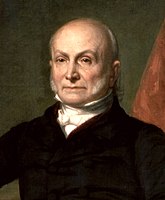

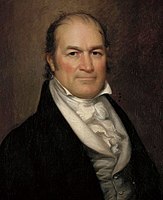
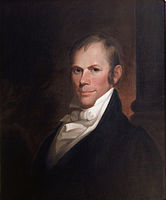
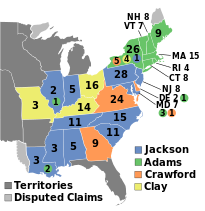

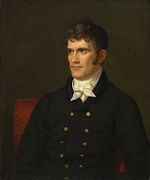
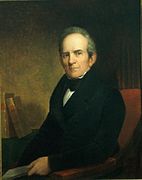

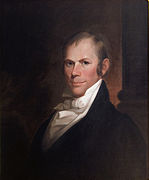




0 Response to "how did the election of 1824 change the way presidents were selected?"
Post a Comment